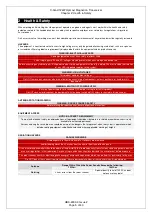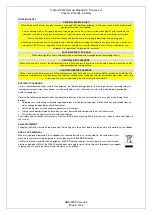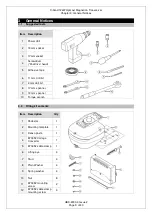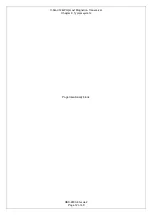
X-band 12kW Upmast Magnetron Transceiver
Chapter 2: Health & Safety
HBK-2300-3 Issue 2
Page 6 of 40
WORKING ALOFT
CAUTION: SAFETY ALOFT
When working aloft or near any radar scanners, moving or RF radiating equipment, ALL power sources to the platform and
equipment must be fully isolated.
Prior to working aloft, all AC supply breakers supplying power to the system must be switched OFF and locked. Ensure
someone in authority or at ground level knows of your intentions and ensure that suitable clear warnings are in place.
Ensure all means of access aloft are secure and beware of wet or slippery ladder rungs and working areas.
All working at height health & safety requirements and procedures including the inspection and use of personal protective
equipment (PPE) such as approved safety harnesses and gloves, must be adhered to at all times as required by your
employer, site regulations, shipyard and / or vessel.
CAUTION: SAFETY CORDON
When working aloft a safety cordon must be established and managed below the working area(s).
CAUTION: DROP HAZARDS
When working aloft, all tools, Line Replacement Units (LRU’s) and any loose items must be safely stowed or secured so that
they cannot present a drop hazard.
CAUTION: WEATHER HAZARDS
When weather conditions are poor, a full risk assessment must be carried prior to working aloft as defined by an individual’s
employer or shipbourne safety procedures. Poor weather conditions can include but are not restricted to high winds, heavy rain,
snow, ice or if access is required at sea, risk of vessel pitch and roll.
ANTI-STATIC HANDLING
Certain semiconductor devices used in the equipment are liable to damage due to static voltage. Persons removing sub-units
from equipment containing these devices must be earthed by a wrist strap and a resistor at the labelled point provided on/
within the equipment.
Observe the following precautions when handling these devices in their un-terminated state, or sub-units containing these
devices:
Soldering irons used during authorised repair operations must be low voltage types with earthed tips and isolated from the
mains voltage by a double insulated transformer.
Outer clothing worn must be unable to generate static charges.
Printed circuit boards fitted with these devices must be stored and transported in anti-static containers.
Fit new devices in a special antistatic safe handling area.
Fully isolate and mechanically disconnect all sources of AC before attaching ESD protective wrist straps to the various points in
the system.
RoHS STATEMENT
For details on RoHS statements please contact Kelvin Hughes Ltd; contact details can be found in at the end of this handbook.
END OF LIFE DISPOSAL
When the equipment detailed in this handbook has reached the end of its serviceable life, the various parts that
make up the system must be disposed of in accordance with
the WEEE Directive.
The Waste Electrical and Electronic Equipment (WEEE) Directive requires the recycling of waste electrical and
electronic equipment. Whilst the WEEE Directive does not apply to some Kelvin Hughes Ltd products, we support
its policy and ask you to be aware of how to dispose of this product.







































